db execution
Execution process: the operators are arranged in a tree.
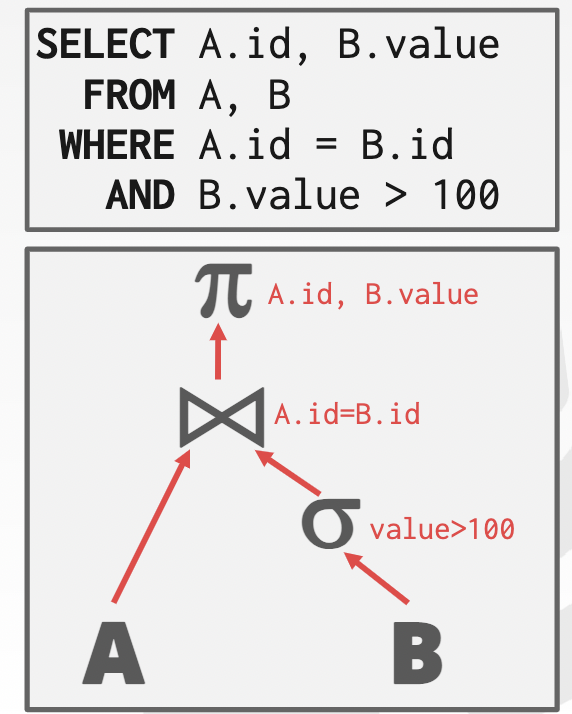
Sorting¶
supported feature: ORDER BY, DISTINCT, GROUP BY
Problem: can’t guarantee sorting data to fit in memory
Approach: external merge sort: splits the data set into separate runs, sorts them individually, and then combine into larger sorted runs.
- run: a list of key/value pairs.
- Key: attributes to compare
- Value: record id/tuple
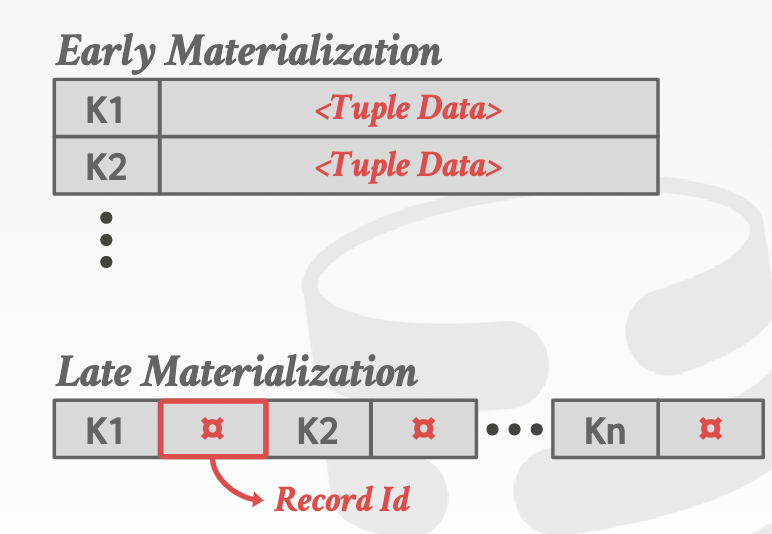
-
Procedure
-
Sorting: sort in memory and then write back to a file on disk
-
Merging: combine sorted sub-files into single file
-
-
2-way external merge sort
-
data set = N pages, buffer pool = B pages
-
Pass:read and write each page in file.

-
Number of passes = 1 + log2N
-
1 represents pass 0 which reads every B pages of the table into buffer pool(memory).
-
In this case, B >= 3(2I, 1O).
-
-
totoal I/O cost: 2N*(# of passes)
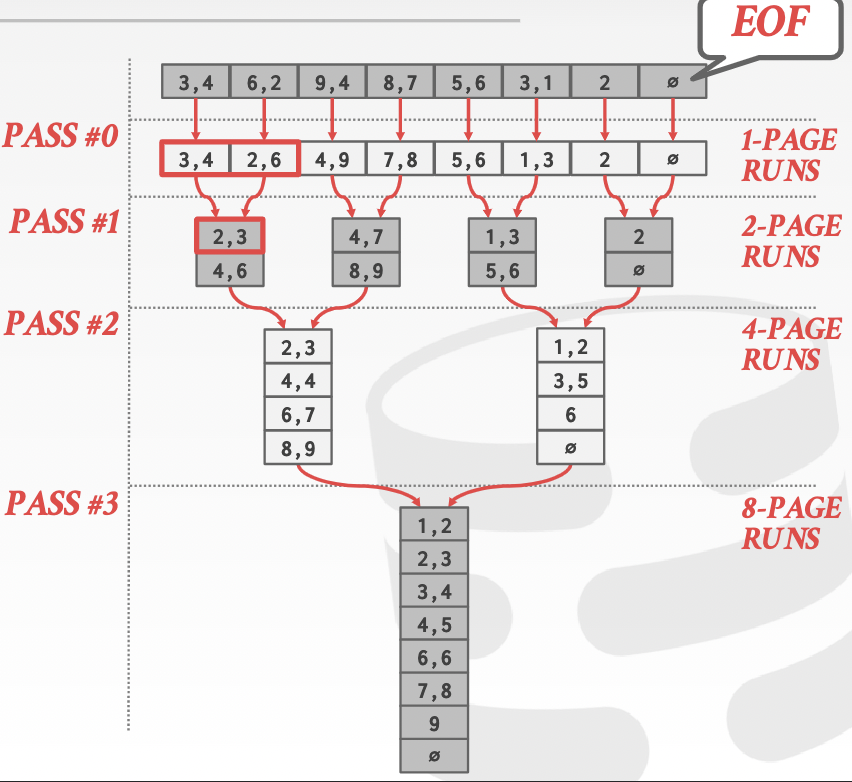
-
Problem: the worker blocks on disk I/O -> more buffer pages won’t help in this case
- Approach:double buffering optimazation: prefetching the next run in the background and storing it in a second buffer while the system is processing the current run.
- pro: reduce the wait time for I/O requests
- Multi-thread env
-
-
General(k-way) merge sort
let k = B -1, #of runs = N/B * B
#of sorted runs = N/B, merge k runs
#of passes = 1 + logB-1(N/B) , total I/O cost = 2N*(# of passes)
-
optimize sorting by using b+ tree: Retrieve tuples in desired sort order by simply traversing the leaf pages of the tree.
The point is # of I/O access.
Case 1: clustered b+ tree: if the index is a clustered index, traverse the tree
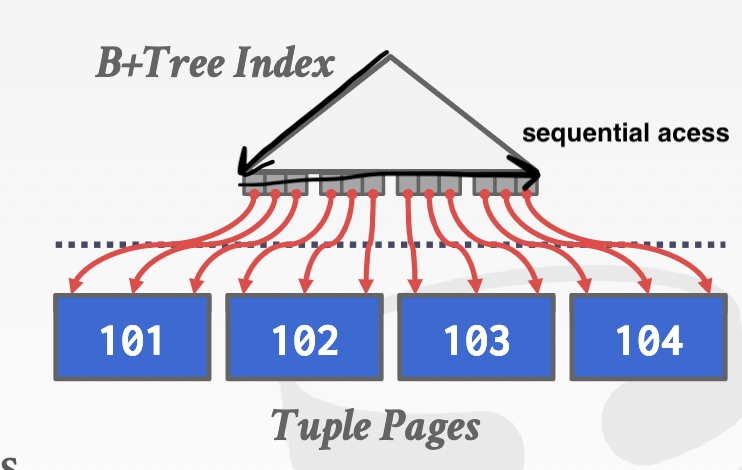
case 2: unclustered b+ tree: else, don’t do it.
Aggregations¶
-
Aggregations: Collapse values for a single attribute from multiple tuples into a single scalar value.
- two approaches for implementations: sorting, hashing
- -> GROUP BY, DISTINCT
-
Sorting -> ordering query
optimization: perform filter first: reduce the amount of data requiring to be sorted.
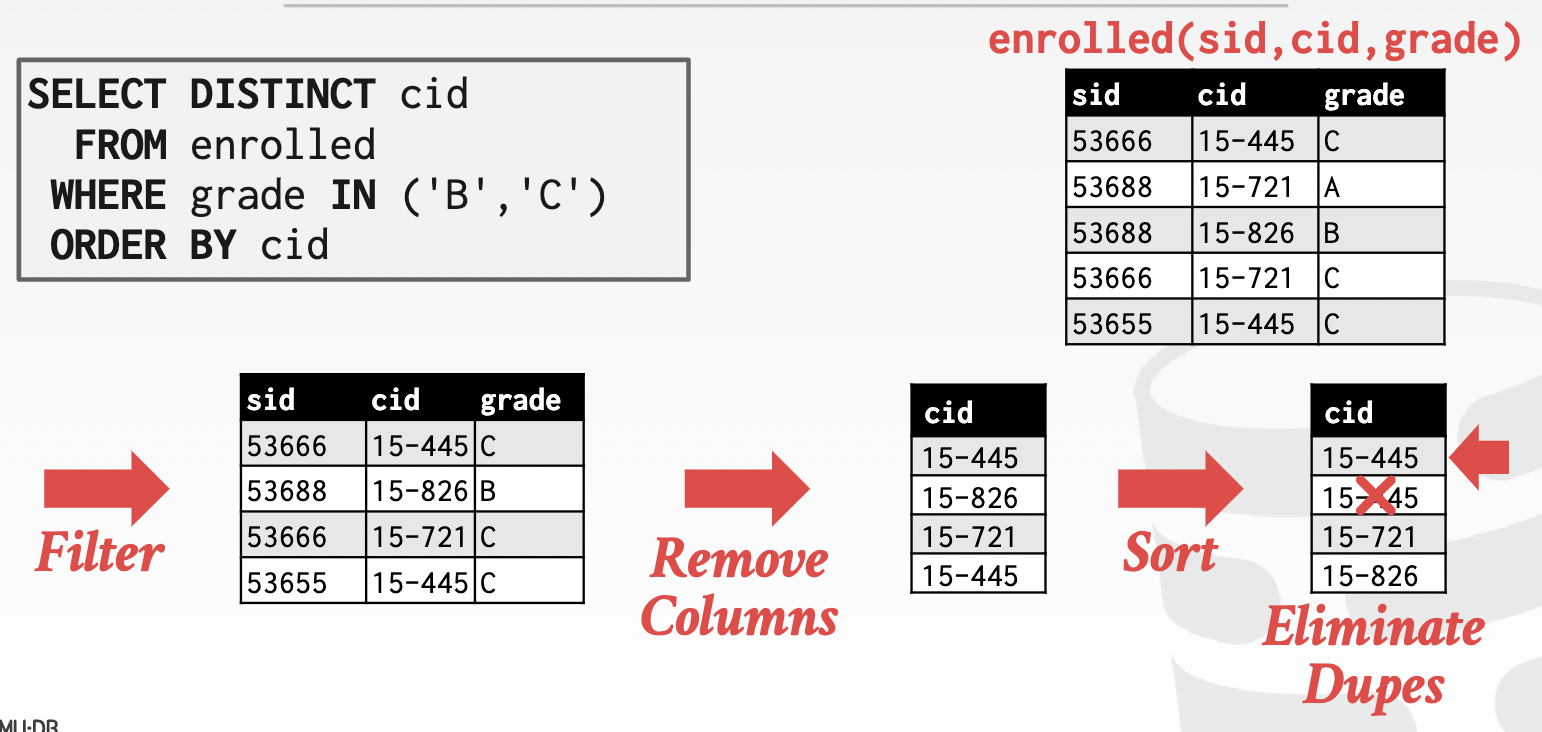
-
Hashing -> no ordering
Like sorting algorithms, DBMS spills data to disk when data doesn’t fit in memory. Two phases for external hashing aggregate: partition, rehash.
The point is the location of operations given context.
-
problem 1: what to split?
- partition: one or more pages that contain the set of keys with the same hash value.
-
problem 2 : how to split?
-
hash function: used to split tuples into partitions on disk
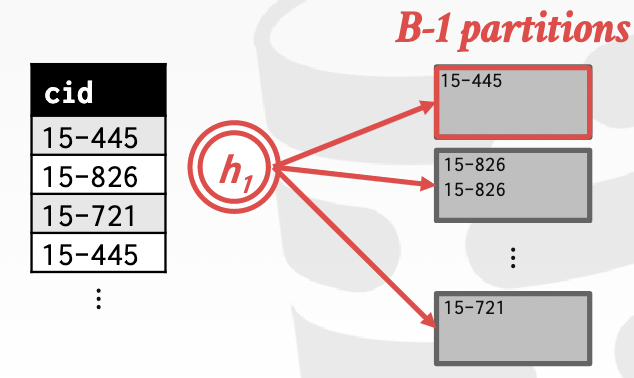
-
rehash: Build in-memory hash table for each partition and compute the aggregation
Assume: each partition fits in memory.
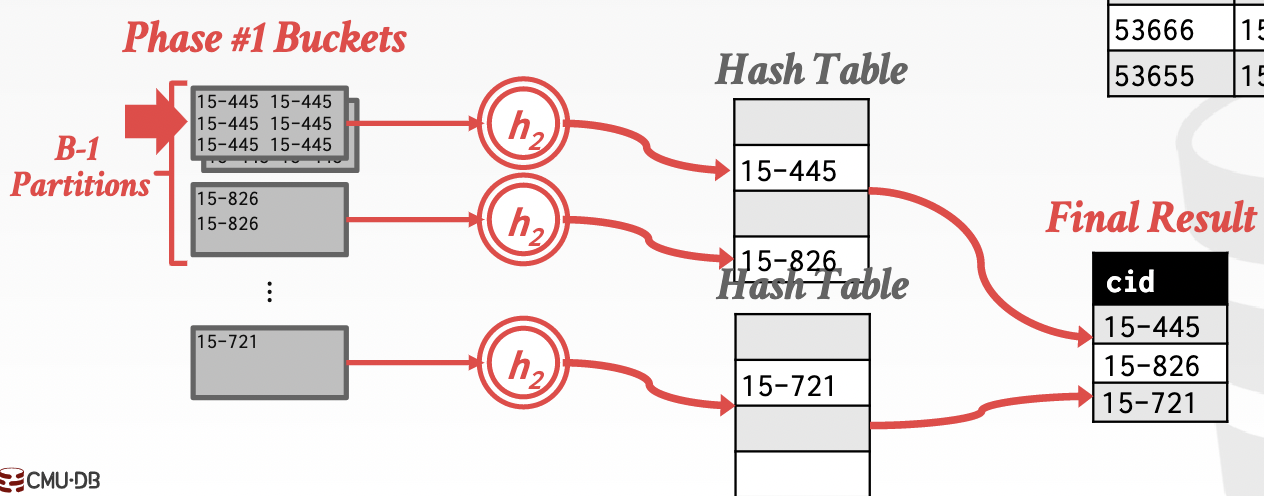
-
-
summarization: result form: (GroupKey -> RunningVal)
scenario: Insert new tuples(G’, R’) into the hash table
- like dictionary insertion: G’ existed, update R to R’; G’ not existed, insert (G’, R’)
-
Joins¶
-
inner equijoin algorithm: joins tables where keys are equal.
-
goal: minimize repetitions
-
Join operators: choose what to join and smart joins
-
operator output: For a tuple r ∈ R and a tuple s ∈ S that match on join attributes, the join operator concatenates r and s together into a new output tuple.
-
early materialization (data): Copy the values for the attributes in outer and inner tuples into a new output tuple. -> no need to go back in the query plan
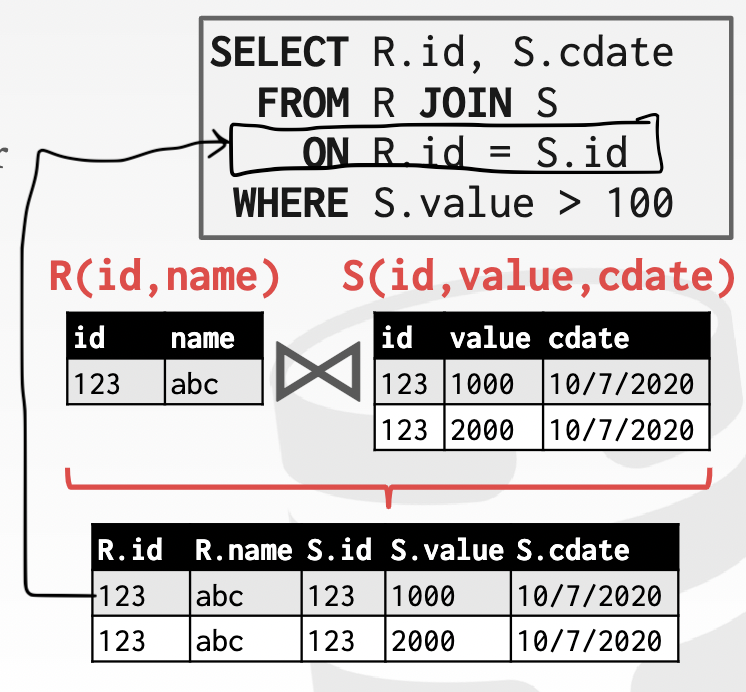
-
late materialization( record ids): Only copy the joins keys along with the record ids of the matching tuples -> suits for column store
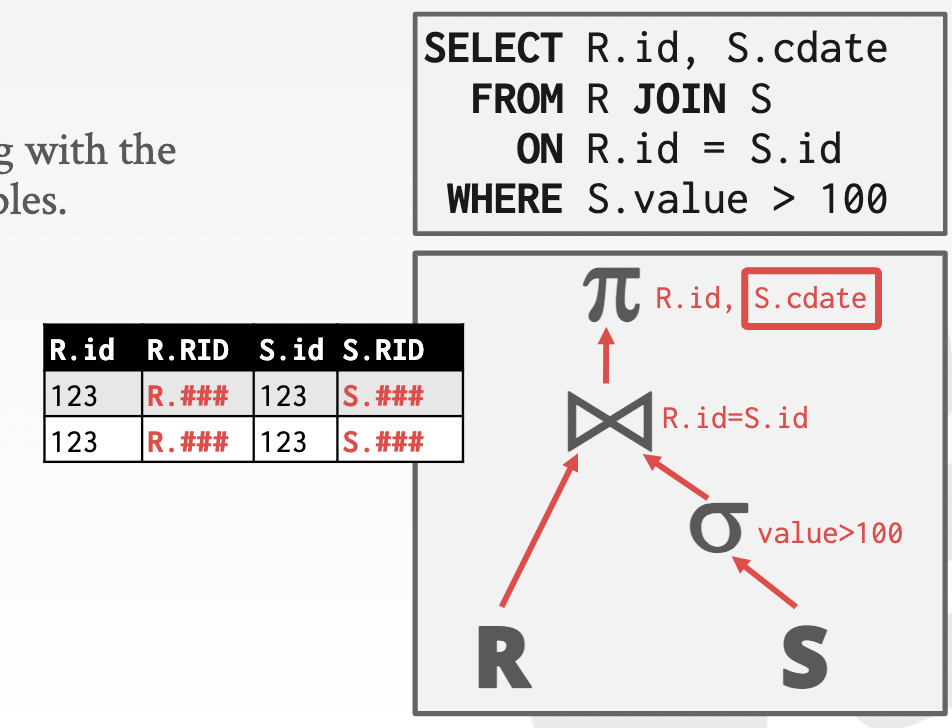
-
-
cost analysis criteria: # of disk I/Os used to compute join
Only count input costs. Because outputs depend on the date computed afterwards.
The point is to find appropriate algorithms in certain scenario.
-
Variables used in this lecture:
- M pages in table R (Outer Table), m tuples total
- N pages in table S (Inner Table), n tuples total
Nested loop join¶
-
Nested loop join: two nested FOR loops that iterate over the tuples in both tables and compares each unique of them.
-
locality:DBMS uses smaller table as the outer table and buffers it in memory.
-
Index: find matches
-
-
Stupid/Simple NLJ:
1
2
3foreach tuple r ∈ R:
foreach tuple s ∈ S:
emit, if r and s match -
Block NLJ:
1
2
3
4
5foreach block B_R ∈ R:
foreach block B_S ∈ S:
foreach tuple r ∈ B_R:
foreach tuple s ∈ B_s:
emit, if r and s match -
Index NLJ
Sort-merge join¶
-
Sort-merge join: sorts the two tables on their join key(s)
1
2
3
4
5
6
7
8
9
10sort R,S on join keys
cursorR ← Rsorted, cursorS ← Ssorted
while cursorR and cursorS:
if cursorR > cursorS:
increment cursorS
if cursorR < cursorS:
increment cursorR
elif cursorR and cursorS match:
emit
increment cursorS -
Cost analysis: sort + merge
Hash join¶
- hash join: use a hash table to split up the tuples into smaller chunks based on their join attribute(s).
- basic hash join
- Grace hash join/Hybrid hash join